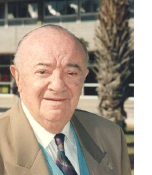 סולי ילין נולד וגדל בעולמה התרבותי התוסס של יהדות וילנה של בין שתי מלחמות העולם.
סולי ילין נולד וגדל בעולמה התרבותי התוסס של יהדות וילנה של בין שתי מלחמות העולם. למרות שבגיל 18 עקר ילין מוילנה לדרום אפריקה הותירו שנותיו בוילנה את רישומן העמוק עליו למשך כל ימי חייו והוא המשיך ועסק במעורבות תרבותית ובחינוך יהודי לאורך חייו.
ילין שימש בתפקידים ציבוריים רבים במסגרת הקהילה היהודית בדרום אפריקה ובכלל זה כיהן כיושב הראש ואחר כך כנשיא הועד הדרום אפריקאי לחינוך יהודי וכן כיו"ר של המגבית הקהילתית המאוחדת. בתפקידיו הרבים עשה רבות להידוק הקשרים בין הקהילה היהודית בדרום אפריקה למדינת ישראל. כציוני גאה, שאף כיהן כסגן נשיא כבוד לחיים של הפדרציה היהודית של דרום אפריקה, זכה ילין בערוב ימיו להגשים את משאת נפשו עלה לארץ ובילה בה את שנותיו האחרונות.
הקתדרה ע"ש סולי ילין לחקר יהדות ליטא ומזרח אירופה מהווה ביטוי נאמן הן לאמונתו בחשיבות הרבה של הלמדנות היהודית והן לגאוותו הבלתי מוסתרת של ילין בשרשיו התרבותיים ביהדות מזרח אירופה. מטרת הקתדרה להעמיק ולעודד מחקר מתקדם הקשור לחייהם ותרבותם של יהודי איזור זה.
The Solly Yellin Chair in Lithuanian and East European Jewish Culture
Solly Yellin was born and raised in the thriving Jewish cultural world of pre-war Vilna. At the age of 18, Yellin moved to South Africa but these early years made a deep impression on him and he maintained a lifelong devotion to Jewish education and culture. He served in many public positions in Jewish community of South Africa including Chairman and thereafter President of the South African Board of Jewish Education and Chairman of the United Communal Fund. He also played a central role in cementing ties between the South African Jewish community and the State of Israel. A proud Zionist who was named honorary Vice-President for life of the South African Zionist Federation, he ultimately fulfilled his lifelong dream and moved to Israel in hi last years.
The Solly Yellin Chair in Lithuanian and East European Jewry is both an expression of Yellin’s belief in the value of Jewish scholarship and extension of his endless pride and joy in eastern European Jewish culture. The Chair strives to encourage advanced research into the achievements of Jews who lived in the region.